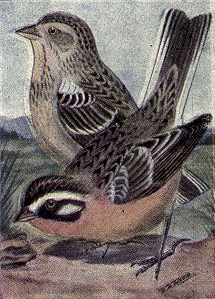Smith's longspur
| Smith's longspur | |
|---|---|

| |
| Scientific classification | |
| Kingdom: | |
| Phylum: | |
| Class: | |
| Order: | |
| Family: | |
| Genus: | |
| Species: | C. pictus
|
| Binomial name | |
| Calcarius pictus (Swainson, 1832)
| |
The Smith's longspur (Calcarius pictus) is a small ground-feeding bird from the family Calcariidae, which also contains the longspurs.
These birds have short cone-shaped bills, streaked backs, and dark tails with white outer retrices. In breeding state plumage (mostly formed by worn basic plumage), the male has a pumpkin-orange throat, nape, and underparts contrasting with an intricate black-and-white face pattern. The white lesser coverts are quite pronounced on a male in spring and early summer. Females and immatures have lightly streaked buffy underparts, dark crowns, brown wings with less obvious white lesser coverts, and a light-colored face. The tail is identical at all ages.
This bird breeds in open grassy areas near the tree line in northern Canada and Alaska. The female lays three to five eggs in a grass cup nest on the ground. These birds nest in small colonies; males do not defend territory. Both males and females may have more than one mate. The parents, one female and possibly more than one male, feed the young birds.
In winter, they congregate in open fields, including airports, in the south-central United States.
Migration is elliptical, with northbound birds staging in Illinois in the spring and southbound birds flying over the Great Plains in the fall.
These birds forage on the ground, gathering in flocks outside of the nesting season. They mainly eat seeds, also eating insects in summer. Young birds are mainly fed insects.
The song is a sweet warble that's inflected at the end, somewhat reminiscent of chestnut-sided warbler. The call is a dry rattle, like a shortened version of the call of a female brown-headed cowbird. It is noticeably drier than that of Lapland longspur.
Audubon named this bird after his friend Gideon B. Smith.
References
Further reading
Books
- Briskie, James V. 1993. Smith’s Longspur (Calcarius pictus). In The Birds of North America, No. 34. (A. Poole, P. Stettenheim, and F. Gill, Eds.). Philadelphia: The Academy of Natural Sciences; Washington, DC: The American Ornithologists’ Union.
External links
- Photo gallery - VIREO

